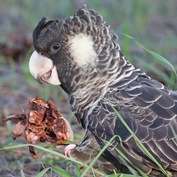High flying technology helping conserve WA's threatened black cockatoos

In a world first, researchers at Murdoch University have teamed up with industry to track endangered Carnaby's cockatoos in the southwest of Western Australia, using state-of-the-art technology developed in the Netherlands that will provide insight into threats to the endangered species.
The Black Cockatoo Ecology Project is funded by Newmont Boddington Gold, South32, Department of Parks and Wildlife, Perth Zoo and PTI Architecture and involves intensive tracking and data capture, which will monitor Carnaby's cockatoos and forest red-tailed black cockatoos over a five-year period.
The research team has fitted birds with uniquely numbered and coloured leg bands, satellite transmitters and solar powered UvA-BiTS GPS trackers, a world first combined tracking method for a parrot species.
Tracking devices are fitted to wild black cockatoos that have been treated for injury at Perth Zoo and undergone rehabilitation for release back into the wild at Kaarakin Black Cockatoo Conservation Centre and Native Animal Rescue.
The tail mounted satellite tag will gather data eight times a day, with the back mounted GPS transmitter providing valuable data every 10 minutes. This precise tracking allows the research team to follow the birds during the long-term project, and to gain a better understanding of their habitat use across their distribution range.
"The accelerometer GPS tracker allows us to get a three dimensional reading of the bird's activity at any time, providing us with detailed fine-scaled information," said Dr Jill Shephard, School of Veterinary and Life Sciences.
"We know exactly where they are and what they are doing from the tracking data and our research team spends a lot of time in the field following the flocks and visually observing the birds. Across the life of the project we will generate huge amounts of data, with more than 36 thousand location fixes and nearly eight thousand kilometres of movement already recorded."
Associate Professor Kris Warren of Murdoch University's School of Veterinary and Life Sciences said researchers know from previous releases and earlier studies that the birds will join wild flocks.
"By following the wild flocks, we're able to better understand the ecology of the species," she said.
"By tracking black cockatoos from as far north as Jurien right down to Esperance, we will be able to identify critical feeding and breeding habitat and how the birds move within those landscapes.
"The tracking data will make an invaluable and unique contribution to decision-making about the conservation management efforts to save Western Australia's threatened black cockatoos."
Provided by Murdoch University




















